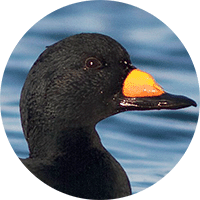Black Scoter
Appearance: The adult male Black Scoter (48 cm - 19 inches) has a predominantly black plumage with a distinctive yellow knob at the base of its thick yellow bill. The female is primarily brown, with a pale cheek and a dark cap extending from the back of the eye to the nape of the neck. They have e a thick, black bill, and the legs and feet are gray in both sexes.
Habitat: Black Scoters are primarily marine birds and breed in the subarctic and boreal regions of North America. During the breeding season, they inhabit freshwater lakes and ponds in forested areas near their nesting sites. In winter, they migrate to coastal waters and can be found in bays, estuaries, and nearshore areas. Dives in deep water.
Behavior: Black Scoters are diving ducks that forage underwater, using their strong wings to propel themselves. They feed primarily on mollusks, crustaceans, and aquatic invertebrates.These ducks may form small flocks during the non-breeding season and often gather in large groups during migration. They are capable of flying long distances.
Breeding: Black Scoters breed in the northern regions of North America, including Alaska and Canada. They construct nests on the ground, usually hidden among vegetation near bodies of water. The female incubates the eggs for about a month while the male leaves to molt. After hatching, the ducklings are precocial, meaning they are relatively independent and capable of swimming and feeding themselves shortly after birth.
Conservation Status: The Black Scoter is considered a species of Near Threatened status by the International Union for Conservation of Nature (IUCN).
Distribution
The Black Scoter duck is a sea duck species primarily distributed in North America and it is a visitor to the Pacific Coat of Colombia
Taxonomy
- Kingdom: Animalia
- Phylum: Chordata
- Class: Aves (birds)
- Order: Anseriformes
- Family: Anatidae
- Genus: Melanitta
- Species: Melanitta americana
Vocalization
Call Notes: Black scoter ducks have a distinctive call that is described as a low, mellow, and nasal "rrooo-err" or "hroo-uh." This call is often given while in flight or during social interactions.
Courtship Displays: During courtship, males may produce an elaborate vocalization known as the "cooing" display. This display involves a series of soft, melodious cooing notes delivered in a rhythmic pattern. It serves as a territorial and courtship display intended to attract females and establish dominance over other males.
Aggressive Calls: When faced with threats or territorial disputes, black scoter ducks can emit harsh and aggressive calls. These calls are shorter and more aggressive in tone compared to their typical call notes. They are used to assert dominance and defend their territory.
Non-vocal Sounds: Besides vocalizations, black scoter ducks also produce various non-vocal sounds. These may include sounds created by their wings during display flights, splashing sounds during takeoff or landing in water, and bill noises like bill fences (clacking bills together) used during aggressive encounters.




